Migrant journey: sixth report
Published 17 February 2016
Published: 17 February 2016
This report is the sixth in a series of reports that explore migrants’ journeys through the UK’s immigration system.
1. Introduction
Understanding the processes that migrants go through when they decide to stay in the UK or switch their immigration status helps to inform Parliament and the public on the impact of changes to the Immigration Rules.
The findings presented here are based on combining data collected from two UK Visas and Immigration (UKVI) databases. These databases hold records of individuals granted entry clearance visas, and any subsequent grants of extensions of stay in the UK.
This report updates analysis from the ‘Migrant journey: fifth report’ published in February 2015. It presents the data in two different and complementary ways, providing information on a forward-view and backward-view of the extent to which different types of non-European Economic Area (EEA) migrants change their immigration status or achieve settlement in the UK. The forward-view analysis examines the immigration status in 2014 of migrants issued visas to the UK in 2004 and in subsequent years. The backward-view analysis looks at those whose entry to the UK ultimately resulted in them being granted settlement, permission to stay permanently in the UK, and which visas they used on arrival to the UK. The latest findings include the cohort of those issued a visa in 2009.
The data presented in this report relate to all cases (main applicant and dependants combined) and the supplementary tables separately identify all cases, by main applicants and by dependants.
2. Key facts
A quarter (25%; 20,437) of those issued a skilled work visa (which has a potential path to settlement) in the 2009 cohort had been granted settlement 5 years after their initial visa had been granted; a further 10% (7,906) still had valid leave to remain in the UK. Of those in this study who are no longer recorded as having valid leave to remain in the UK, a proportion may still be illegally present. However, it is not possible to measure this from these data, which measure legal granted visa statuses.
Indian nationals were issued the largest proportion (41% of the total) of skilled work visas in the 2009 cohort and, of these skilled Indian nationals, 24% had received settlement after 5 years, while a further 8% still had valid leave to remain in the UK. These are slightly lower than the average rates for all skilled workers.
Of the top 5 nationalities issued a skilled work visa in the 2009 cohort, American and Australian nationals were less likely to have settled after 5 years (12% and 11% respectively), whereas Pakistani nationals were more likely to have settled (47% of Pakistani skilled workers had reached settlement by 2014).
Around three-quarters of people (77%; 28,704) issued a family visa in the 2009 cohort had been granted settlement 5 years later, with a further 4% recorded as still having valid leave to remain in the UK. The proportion of family visa holders remaining in the UK legally 5 years after arrival has risen in each successive cohort between 2004 and 2008, while the 2009 figure is the same as that for the 2008 arrivals.
Of the top 5 nationalities issued a family visa in the 2009 cohort, Americans (63%) and Somalis (62%) were the least likely to have been granted settlement within 5 years; Bangladeshi (92%), Pakistani (86%) and Indian nationals (84%) were the most likely.
Migrants granted a student or a work visa (not leading to settlement) in 2009, both largely temporary migration routes, were less likely to have achieved settlement or have valid leave to remain in the UK after 5 years (17% and 7% respectively). Of these, only a small proportion had achieved settlement (1% and 2% respectively) within the 5-year timeframe; the reasons for this include:
- the rules for these visa categories
- the propensity for people in these categories to switch into other immigration categories that have a route to settlement
- the time that would then need to elapse before a settlement application can be made
The proportion of those granted a visit visa that had achieved settlement or had valid leave to remain in the UK after 5 years is low and has been fairly consistent across all cohorts at 3% or less.
Of those granted settlement in the 2014 cohort, around two-fifths (41%) had originally been issued a visa that could potentially lead to settlement (family or skilled work) and a further 11% were granted settlement on arrival. A similar proportion (42%) originally entered on a temporary route and later switched into a route that led to permanent settlement.
Proportion of non-European Economic Area migrants issued a visa in each year 2004 to 2009 who still held valid leave to remain in the UK or had been granted settlement after 5 years, by visa type
| Cohort | Family | Skilled work (with a potential path to settlement) | Temporary work (not leading to settlement) | Study | Visit | Dependants joining or accompanying |
|---|---|---|---|---|---|---|
| 2004 | 68% | 44% | 11% | 24% | 3% | 50% |
| 2005 | 70% | 43% | 10% | 21% | 3% | 51% |
| 2006 | 75% | 41% | 9% | 20% | 3% | 53% |
| 2007 | 79% | 32% | 8% | 18% | 2% | 58% |
| 2008 | 81% | 29% | 7% | 18% | 2% | 54% |
| 2009 | 81% | 35% | 7% | 17% | 3% | 52% |
Table notes
Source: Home Office, Migrant journey, tables MJ 01 to 06.
The Points Based System was phased in during 2008. Tier 1 (which provides a route for highly skilled migrants) was phased in between February and June 2008, followed by Tier 2 (which provides a route for skilled workers with a job offer) and Tier 5 (which is for temporary workers and youth mobility, providing a route for those coming to the United Kingdom for primarily non-economic reasons) which were implemented in November 2008. These changes to the rules may have influenced the characteristics of those arriving for work after 2008.
Immigration status after 5 years of those issued a visa in 2009, by visa type

Chart notes
Source: Home Office, Migrant journey, tables MJ 01 to MJ 06.
3. Forward-view analysis
The forward-view analysis examines the changes in immigration status of migrants issued visas to the UK in 2009. In addition, potential changes in migrant behaviour over time are explored by comparing results for the 2009 cohort with the cohorts of those issued visas in each year from 2004 to 2008.
There are 6 main routes of entry to the UK for migrants from outside the European Economic Area (EEA). The forward-view analysis explores these routes, which are:
- family
- skilled work (with a potential path to settlement)
- temporary work (not leading to settlement)
- study
- visit (for those from non-EEA countries who are required to hold a visit visa)
- dependants joining or accompanying
The analysis tracks migrants who were initially issued a visa in one of these routes through the immigration system in each subsequent year, in order to identify their immigration status at the end of the fifth year after their initial arrival. Analysis of the immigration status at the end of the eighth year after entry is examined in this report for the first time for the earlier cohorts. The forward-view analysis of migrants issued visas in 2004, 2005, 2006, 2007, 2008 and 2009 identifies the points at which an individual’s entry clearance visa or extension of stay changed category or expired.
The expiration of an individual’s entry clearance visa or extension of stay does not necessarily confirm that the migrant has left the UK and returned to their home country. In fact, there are 4 possible outcomes for such migrants:
- the migrant has left the UK
- the migrant is still in the UK (as an overstayer)
- the migrant has made an application for a further extension of stay that has not been identified or recorded
- the migrant never travelled to the UK (the visa was not used)
The figures presented here do not contain estimates of the proportion of those whose entry clearance visa or extension of stay has expired who have left the UK. (Exit checks to check on expiration of leave to remain in the UK were introduced from April 2015 and an initial report on these data has been pre-announced to appear on May 26, 2016.)
4. 2009 cohort by immigration status at the end of each year
Those issued a family visa in 2009 were most likely to have achieved settlement or still have valid leave to remain in the UK 5 years after their arrival (81%; 30,112). The chart below shows for each of the visa types analysed the proportion still holding a valid visa or who had gained settlement in each year after their initial arrival. The patterns reflect the different rules that apply to each visa type. As expected the decline over time is most rapid for those initially granted visit visas, who are mainly short-term tourists, and is slowest for the family visas where the majority are ultimately granted settlement. The decline for those originally arriving on study visas is less rapid than for those on temporary work visas, but more rapid than for those on skilled work visas (which have a potential path to settlement).
Of the 2009 work route (not leading to settlement) cohort, 58% (31,481) still had valid leave to remain in the UK or had been granted settlement in 2010, but this dropped considerably the following year, to 10% (5,346) in 2011. This reduction is expected, as those who applied under a temporary worker scheme (the work route that does not lead to settlement) are likely to have only intended to stay in the UK for a short period of time.
Migrants in the 2009 cohort still holding valid leave to remain in the UK or granted settlement at the end of each year, by visa type
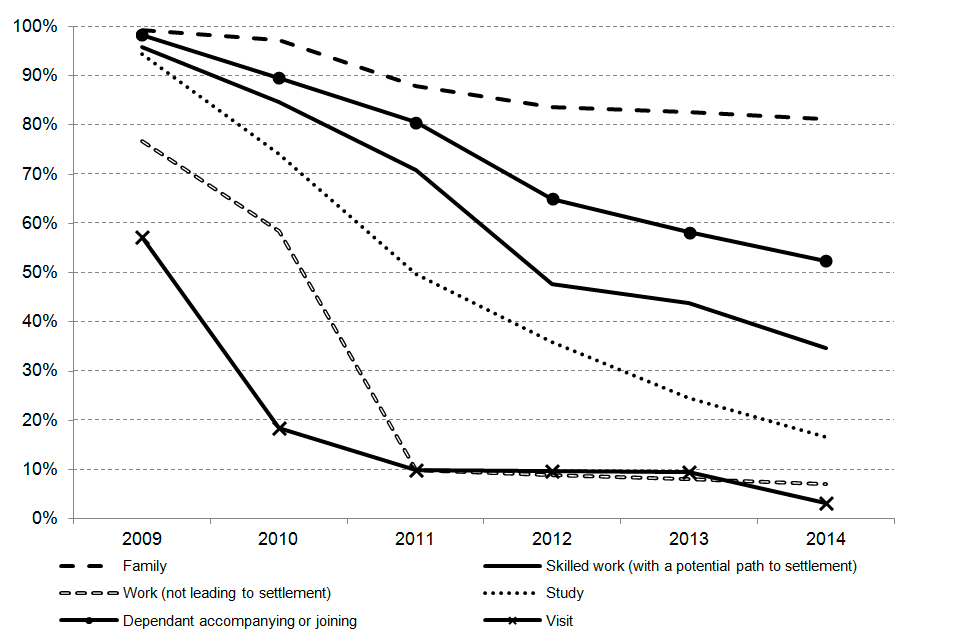
Chart notes
Source: Home Office, Migrant journey, tables MJ 01 to MJ 06.
4.1 Family
For people issued a family visa in 2004, almost two-thirds (63%) had gained settlement (permission to stay permanently in the UK) 5 years later. This proportion increased for those in later cohorts, with over three-quarters (77%) of those issued a family visa in 2008 and 2009 granted settlement 5 years later.
This can be accounted for by migrants on the family route taking up settlement when they become eligible after 2 years, rather than extending their leave to remain in the UK. Of the people issued a family visa in 2009, 44% had gained settlement after 2 years.
Comparison of migrants issued a visa in the family route in each year cohort 2004–2009, by their immigration status 5 years later
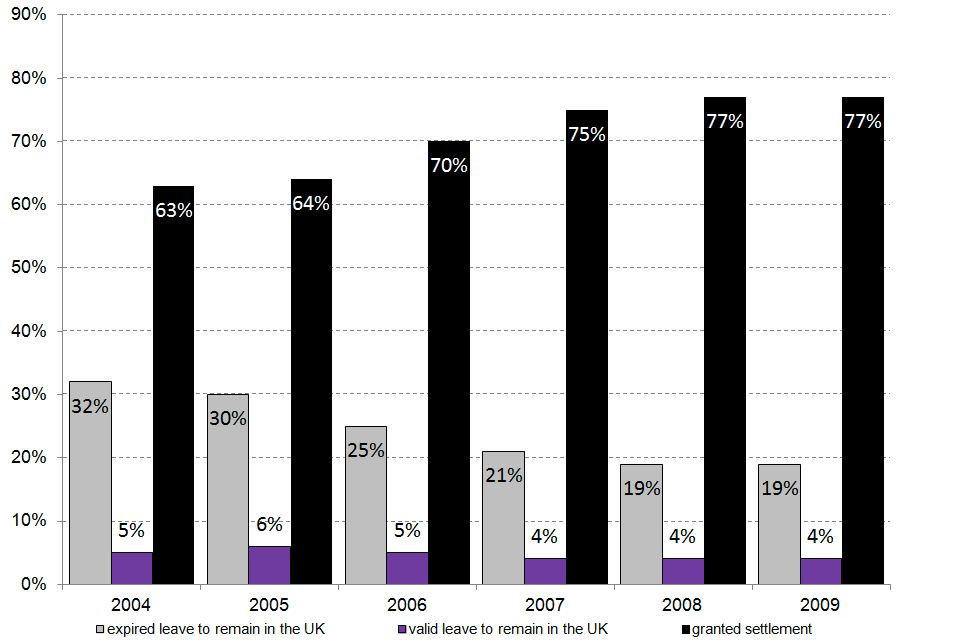
Chart notes
Source: Home Office, Migrant journey, table MJ 01.
In the 2009 cohort, the top 5 nationalities accounted for around two-fifths (41%) of the visas issued through the family route. These nationalities were Pakistani, Indian, American, Bangladeshi and Somali; of whom the largest number were Pakistani nationals, as shown in the table below.
The proportion who had settled within 5 years also differs by nationality. For example, a lower proportion of American (63%) and Somali (62%) nationals were settled after 5 years, compared with nationals from Bangladesh (92%), Pakistan (86%) and India (84%).
Top 5 nationalities in the 2009 cohort issued a family visa
| Nationality | Migrants in 2009 cohort | Immigration status 5 years later: % with expired leave to remain in the UK | Immigration status 5 years later: % with valid leave to remain in the UK | Immigration status 5 years later: % granted settlement |
|---|---|---|---|---|
| All nationalities | 37,098 | 19% | 4% | 77% |
| Of which: | ||||
| Pakistani | 5,973 | 10% | 4% | 86% |
| Indian | 3,236 | 12% | 4% | 84% |
| American | 2,083 | 34% | 3% | 63% |
| Bangladeshi | 2,051 | 5% | 3% | 92% |
| Somali | 1,715 | 37% | 1% | 62% |
Table notes
Source: Home Office, Migrant journey, table MJ 01.
4.2 Skilled work (with a potential path to settlement)
Around a third (30%) of people issued a visa for skilled work in 2004 had gained settlement 5 years later, and a further 15% still had valid leave to remain in the UK.
Comparison of the 2004 cohort with the 5 subsequent cohorts indicates that there has been an overall rise in the proportion of people whose leave to remain in the UK had expired after 5 years, from 56% of those issued a skilled work visa in 2004 to 71% in 2008, although this decreased again to 65% in the 2009 cohort. The rise in expired visas is mirrored by a fall in the proportion of people from these cohorts who still had valid leave to remain in the UK after 5 years, from 15% for those who were issued a visa in 2004 to 8% for those in 2008 (increasing to 10% for the 2009 cohort). These changes coincide with the economic recession, which may have reduced the likelihood of some migrants applying to remain longer in the UK.
Comparison of migrants issued a visa in the skilled work route (with a potential path to settlement) in each year 2004–2009, by their immigration status 5 years later
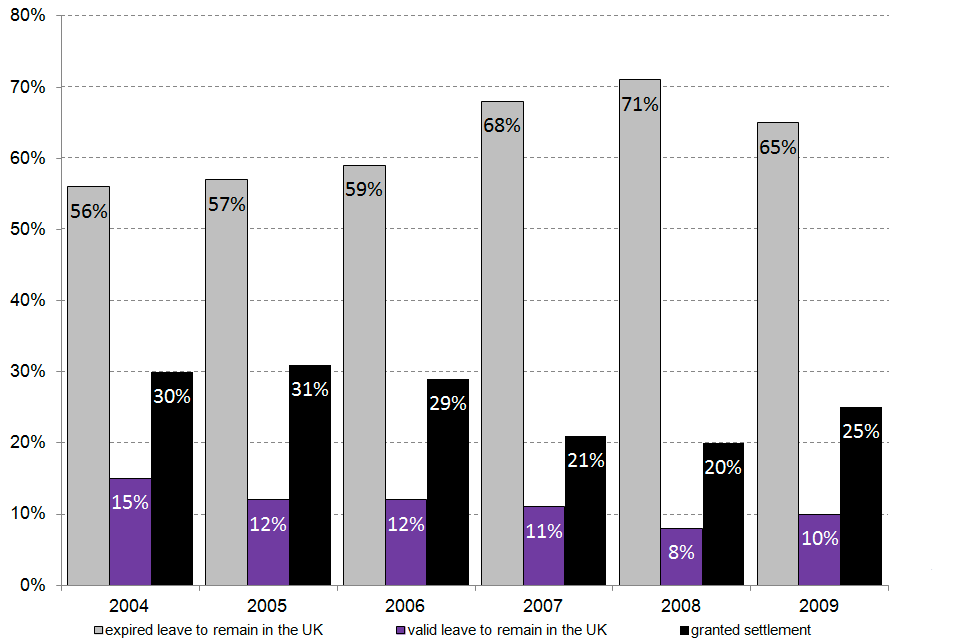
Chart notes
Source: Home Office, Migrant journey, table MJ 02.
In the 2009 cohort, just 5 nationalities accounted for over two-thirds (68%) of the skilled work route. These 5 nationalities were Indian, American, Australian, Pakistani and South African (see table below). Indian nationals comprised by far the largest number of non-EEA skilled workers, at 41% of the total.
Of the top 5 nationalities for skilled workers granted a visa in 2009, Pakistani nationals were most likely to have obtained settlement after 5 years (47%) and also had the highest proportion of dependants (57%) compared with other nationalities. In contrast, a lower proportion of Americans and Australians had been granted settlement after 5 years (12% and 11% respectively).
Under two-thirds (58%) of all those issued a skilled work visa in the 2009 cohort were main applicants, and 42% were their dependants. The number of dependants in this cohort is higher than for other routes and differs by nationality, as shown in the table below.
Top 5 nationalities in the 2009 cohort issued skilled work visas (with a potential path to settlement)
| Nationality | Migrants in 2009 cohort | Proportion who were dependants | Immigration status 5 years later: % with expired leave to remain in the UK | Immigration status 5 years later: % with valid leave to remain in the UK | Immigration status 5 years later: % granted settlement |
|---|---|---|---|---|---|
| All nationalities | 81,810 | 42% | 65% | 10% | 25% |
| Of which: | |||||
| Indian | 33,657 | 44% | 68% | 8% | 24% |
| American | 9,006 | 38% | 77% | 11% | 12% |
| Australian | 4,904 | 16% | 81% | 8% | 11% |
| Pakistani | 4,617 | 57% | 41% | 12% | 47% |
| South African | 3,259 | 24% | 61% | 9% | 30% |
Table notes
Source: Home Office, Migrant journey, table MJ 02.
4.3 Temporary work (not leading to settlement)
As expected, migrants issued a temporary work visa are least likely to have valid leave to remain in the UK after 5 years, compared with all other non-visit visa types. Of those issued temporary work visas in 2004, only 9% still had valid leave to stay in the UK after 5 years. This proportion fell to 5% for the 2008 and 2009 cohorts. Those obtaining further leave to remain in the UK will have done so through switching into alternative visa routes. Just 2% of had gained settlement within 5 years of arriving.
The majority of migrants who entered the UK in this route unsurprisingly stayed in the UK for a relatively short period of time. After 2 years, 90% of the people issued a temporary work visa in 2009 had expired leave to remain in the UK. By the fifth year after their arrival, 7% had valid leave to remain in the UK or a grant of settlement.
Comparison of migrants issued a visa in the temporary work route (not leading to settlement) in each year 2004 to 2009, by their immigration status 5 years later
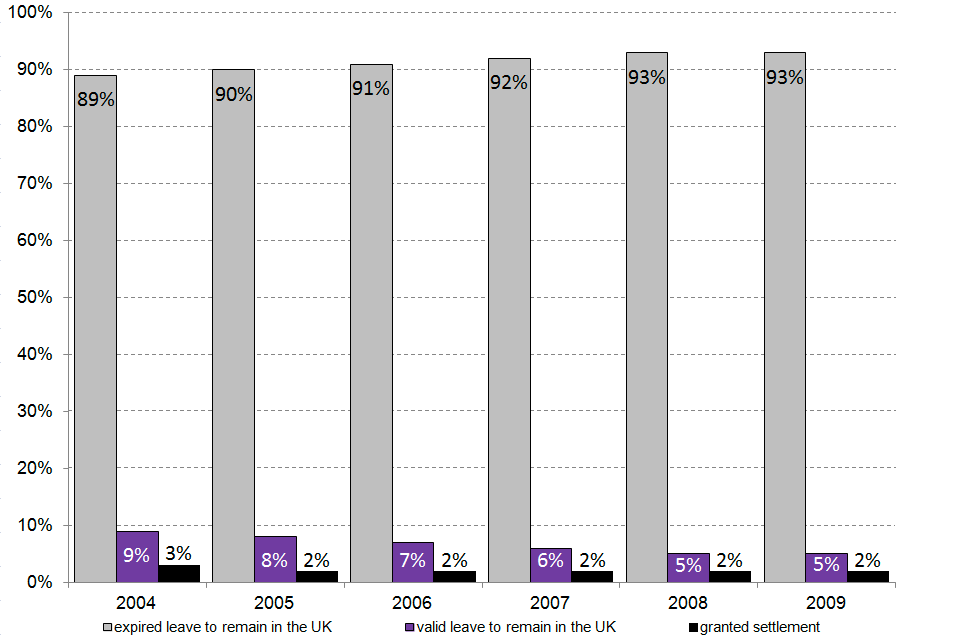
Chart notes
Source: Home Office, Migrant journey, table MJ 03.
The majority of those granted a temporary work visa in 2009 were main applicants (95%), reflecting the fact that these visas will not normally bring rights for accompanying family members.
In the 2009 cohort, the top 5 nationalities accounted for over half (60%) of the temporary work route. The largest number were Australians coming to the UK as working holidaymakers, normally for a period of up to 2 years.
Top 5 nationalities in the 2009 cohort issued a temporary work visa
| Nationality | Migrants in 2009 cohort | Immigration status 5 years later: % with expired leave to remain in the UK | Immigration status 5 years later: % with valid leave to remain in the UK | Immigration status 5 years later: % granted settlement |
|---|---|---|---|---|
| All nationalities | 53,917 | 93% | 5% | 2% |
| Of which: | ||||
| Australian | 12,489 | 95% | 3% | 1% |
| Indian | 8,063 | 90% | 8% | 3% |
| Filipino | 4,957 | 95% | 5% | 1% |
| Canadian | 3,431 | 92% | 5% | 3% |
| New Zealander | 3,371 | 92% | 6% | 2% |
Table notes
Source: Home Office, Migrant journey, table MJ 03.
This route does not lead to settlement and some categories do not allow migrants to bring their dependants. Those migrants in this route who have achieved settlement will in most cases have married settled persons or British citizens or switched into other routes. Analysis of the previous category of individuals granted an extension in 2011 and 2012 is given in the article ‘Extensions of stay by previous category’. Updates for 2014 of the more detailed tables provided in the article are included in the Extensions tables in the Immigration Statistics release.
4.4 Study
The large majority (76%) of migrants issued a study visa in 2004 no longer had valid leave to remain in the UK 5 years later. This proportion has increased in each cohort arriving from 2005, to 83% for those issued a study visa in 2009.
Conversely, the proportion of migrants who gained settlement 5 years after entering on a study visa declined over the same period. For people issued a study visa in 2004, only 3% had gained settlement 5 years later, and a further 21% still had valid leave to stay in the UK, either as students or in another route. For those arriving in 2009, only 17% had valid leave to remain in the UK or had obtained settlement in 2014.
These changes are consistent with the tightening of the Immigration Rules for students since September 2007 (for details please see the user guide policy changes). They may also be partly related to the economic recession that occurred towards the end of the period analysed here, which may have reduced the incentive for students to remain and seek work in the UK. The study group reported on here excludes student visitor visas that cannot be extended and normally have validity of 6 months or in some cases up to 11 months.
Comparison of migrants issued a visa to study in each year 2004–2009, by their immigration status 5 years later
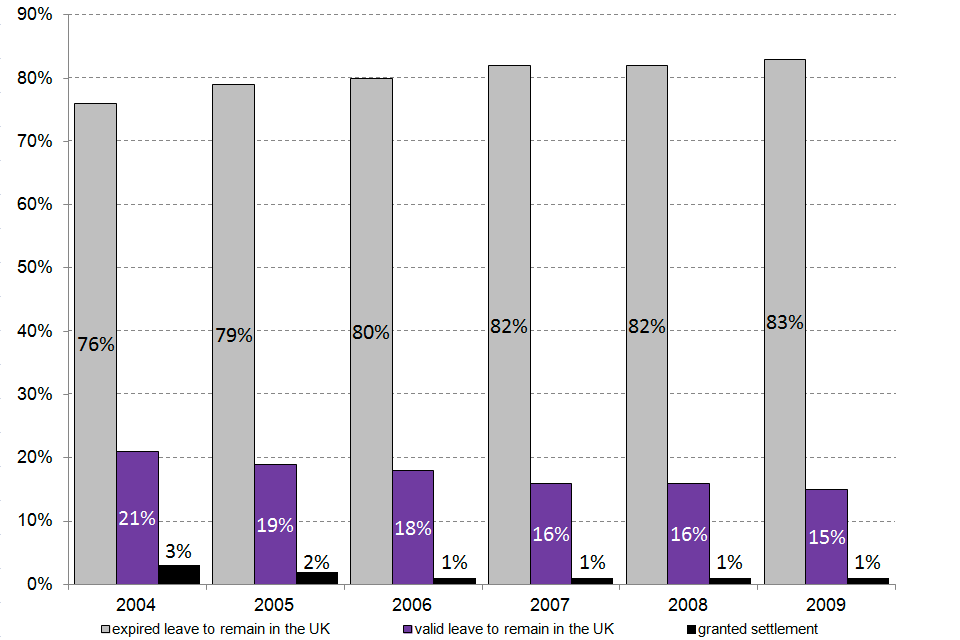
Chart notes
Source: Home Office, Migrant journey, table MJ 04.
Of the people issued a study visa in 2009, 50% had expired leave to remain in the UK after just 2 years, reflecting the fact that many people on student visas will come to study short courses, including both postgraduate studies or further education courses. Almost two-thirds (60%) of non-EU students who started at a UK university in 2009/10 were studying a postgraduate course, rather than an undergraduate degree.
In the 2009 cohort, just 5 nationalities accounted for half (50%) of the people who entered the UK via the study route. These nationalities were Indian, Chinese, Bangladeshi, American and Saudi Arabian (see the table below).
The majority (90%) of those granted a study route visa in 2009 were main applicants (the student); the remaining 10% were those travelling as a dependent family member. Of the visas issued to the fifth largest nationality group in 2009, Saudi Arabian students, 45% were issued to dependants, meaning that, on average, there was one dependant accompanying almost every Saudi student – the highest proportion of the top 5 nationalities and much higher than the 10% for students as a whole. In contrast, just 1% of the visas issued to Chinese students were to dependants.
Almost a third (31%) of Bangladeshi students had valid leave to remain in the UK or had obtained settlement after 5 years, the highest proportion among the top 5 and twice the proportion for non-EU students as a whole (16%).
Top 5 nationalities in the 2009 cohort issued a study visa
| Nationality | Migrants in 2009 cohort | Proportion who were dependants | Immigration status 5 years later: % with expired leave to remain in the UK | Immigration status 5 years later: % with valid leave to remain in the UK | Immigration status 5 years later: % granted settlement |
|---|---|---|---|---|---|
| All nationalities | 280,730 | 10% | 83% | 15% | 1% |
| Of which: | |||||
| Indian | 61,169 | 9% | 84% | 16% | 1% |
| Chinese | 34,623 | 1% | 85% | 15% | 1% |
| Bangladeshi | 17,267 | 4% | 69% | 30% | 1% |
| American | 14,654 | 3% | 92% | 7% | 1% |
| Saudi Arabian | 13,630 | 45% | 88% | 12% | 0% |
Table notes
Source: Home Office, Migrant journey, table MJ 04.
4.5 Dependants joining or accompanying
‘Dependants joining or accompanying’ are people who have been issued a visa on the basis of their relationship with another migrant, who is not a settled person or British citizen and may have been issued a visa for any reason (for example, work, study, family). Dependants are allocated an entry clearance category according to the circumstances of their application. Please see the ‘User Guide to the Home Office Migrant Journey’ for further information on the entry clearance rules for dependants.
For people issued a dependants joining or accompanying visa in 2009, almost half (46%) had gained settlement (permission to stay permanently in the UK) 5 years later, and a further 7% still had valid leave to remain in the UK.
Comparison of migrant cohorts issued a visa through the dependants joining and accompanying route, by immigration status 5 years later

Chart notes
Source: Home Office, Migrant journey, table MJ 06.
In the 2009 cohort, the top 5 nationalities accounted for over half (56%) of the visas issued through the dependants joining or accompanying route.
The top 5 nationalities for dependants joining or accompanying differ in the proportion with leave to remain in the UK still valid after 5 years, as shown in the table below. Nationals of Nepal or Afghanistan were most likely to have been granted settlement after 5 years (82%), as were the majority of Indian and Pakistani nationals arriving as dependants, compared with a very low proportion of Americans (3%).
Top 5 nationalities in the 2009 cohort issued a dependants joining or accompanying visa
| Nationality | Migrants in 2009 cohort | Immigration status 5 years later: % with expired leave to remain in the UK | Immigration status 5 years later: % with valid leave to remain in the UK | Immigration status 5 years later: % granted settlement |
|---|---|---|---|---|
| All nationalities | 16,372 | 48% | 7% | 46% |
| Of which: | ||||
| American | 3,387 | 88% | 9% | 3% |
| Indian | 1,773 | 35% | 6% | 59% |
| Pakistani | 1,601 | 30% | 6% | 63% |
| Nepalese | 1,189 | 16% | 3% | 82% |
| Afghan | 1,164 | 15% | 3% | 82% |
Table notes
Source: Home Office, Migrant journey, table MJ 06.
4.6 Visit
This section provides details of the migrants who started their journey with a visit visa granted in the cohort year. Different types of visit visas are available to suit the purpose of the visit (for example, tourism, business, family and study). Some nationalities, referred to as non-visa nationals, can enter the UK without a visa providing the purpose of the stay is visit-related. Non-visa nationals accounted for around two-thirds (69%) of all non-EEA visitors in 2014, therefore the results reported here will not reflect the full picture for all non-EEA visitors arriving in the UK in the period covered.
A visit visa provides leave to stay in the UK for up to 6 months at a time for those non-EEA nationalities required to obtain one. However, those in possession of a visit visa may be able to enter for longer periods to allow for multiple visits (in some cases up to 10 years). This means that the visitor figures need to be interpreted with care.
For people issued a visit visa in 2004, 2005 and 2006, 2% still had valid leave to stay in the UK 5 years after their initial arrival, and a further 1% had gained settlement after the same length of time. For the later cohorts, valid leave to remain in the UK after 5 years increased from 1% for those issued a visit visa in 2007 to 3% for those in 2009, with 0% of the 2007 to 2009 cohorts achieving settlement after 5 years.
As the purpose of travel for most visitors is short term and temporary, it is not expected that many visitors would be present 5 years after their initial arrival. The vast majority of visit journeys are ‘visit visa only’ (that is, there is no subsequent application for a non-visit visa or case recorded on the ‘in-country’ administrative database). Of the people issued a visit visa in 2009, 90% had expired leave to remain in the UK after 2 years and 97% after 5 years. These percentages partly reflect the issue of multiple entry visit visas, which can have validity for up to ten years. These allow the holder to visit for repeated periods of up to six months within the period of validity. For the 2009 cohort, just 3% of people issued a visit visa still had valid leave to remain in the UK (or had obtained settlement) after 5 years (44,618). Of these, 71% still held a valid visit visa, 11% had been granted settlement, and the remaining 18% had switched into an alternative migration route.
4.7 Migrants in each cohort still holding valid leave to remain in the UK or granted settlement after 8 years
For the first time, analysis tracking migrants at the end of their eighth year after their visa was granted has been included in the report. This additional analysis was not possible previously due to the quality of computer records held in the immigration system prior to the periods covered by this report; in earlier years the majority of records would have been held on paper making quantitative analysis of this sort impractical. However, the results of this analysis show similar findings to the fifth year after entry:
- a higher proportion of family migrants still had valid leave to remain in the UK or had settled after 8 years, when visas were issued in 2006, compared with the 2 preceding years
- the proportion of migrants who still had valid leave to remain in the UK or had been granted settlement after 8 years was lower for those issued a work visa in 2006 than for those issued a work visa in 2004, once again possibly reflecting the prevailing economic conditions as well as changes to the Immigration Rules
- more than one in eight (13%) of those arriving on a student visa in 2006 still had valid leave to remain in the UK or had settled 8 years after entry, as did 7% of those who had initially arrived for short-term or temporary work
Migrants in each cohort still holding valid leave to remain in the UK or granted settlement after 8 years, by visa type1
| Cohort | Family | Skilled work (with a potential path to settlement) | Temporary work (not leading to settlement) | Study | Visit | Dependants joining or accompanying |
|---|---|---|---|---|---|---|
| 2004 | 67% | 41% | 9% | 18% | 3% | 47% |
| 2005 | 69% | 39% | 8% | 15% | 3% | 47% |
| 2006 | 74% | 38% | 7% | 13% | 3% | 49% |
Table notes
Source: Home Office, Migrant journey, tables MJ 01 to 06. (1) Data for 2007, 2008 and 2009 cohorts are not available.
5. Backward-view analysis
The migrant journey analysis also considers those whose entry to the UK ultimately results in them applying for settlement, permission to stay permanently in the UK, and which visas they used initially to come to the UK. The final part of this report looks at the immigration case histories of migrants who were granted settlement in each year from 2009 to 2014.
Limitations of data matching, available data and the rules for settlement mean that it was not always possible to trace every case back to the first visa record. In addition, some original entry records will pre-date the electronic databases used for this analysis, meaning that the migrants could not be linked to an initial visa record.
Numbers of cases granted settlement can also reflect management decisions and other policy changes. The higher volume of cases granted settlement in 2010 reflects more grants given on a discretionary basis. This resulted from a review of the backlog of cases involving unsuccessful asylum applications announced in July 2006 by the then Home Secretary.
The most common pathways to settlement are the family and skilled work routes; the direct routes to settlement allowed under the Immigration Rules. Both of these allow a grant of settlement without the migrant switching to another immigration category. Of those migrants granted settlement in 2014, around two-fifths (41%) had originally entered the UK on either a skilled work or a family visa, but this proportion has fluctuated across cohorts, as shown in the chart below.
Around a quarter (23%) of those granted settlement in 2014 originally arrived to study, or had accompanied a student. This proportion has increased from 10% of those granted settlement in 2009. As this is a temporary route, these student migrants will, in most cases, have subsequently switched into a route to permanent settlement.
A further 11% of migrants in the 2014 cohort had settlement as their first record. This means that they had either been granted settlement on arrival – indefinite leave to enter the UK (ILE) – or had a grant of indefinite leave to remain in the UK (ILR) as their earliest record.
Common immigration routes of those granted settlement in 2009–2014
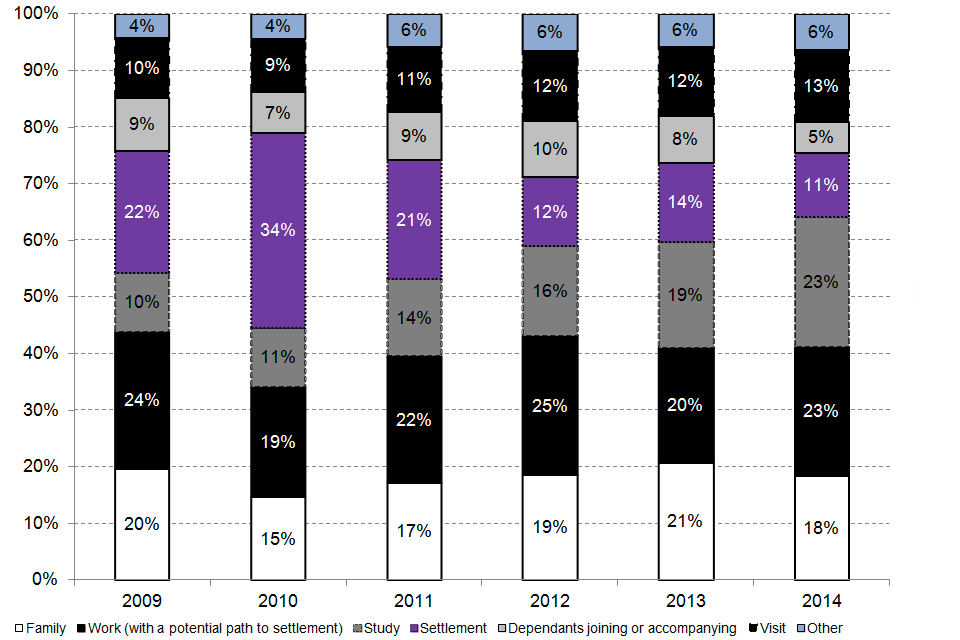
Chart notes
Source: Home Office, Migrant journey, table MJ 07. The chart displays the most common immigration routes.
The number of dependants granted settlement in 2014 differed according to the initial route of entry, as shown in the table below. Over two-thirds (71%) of the total number of settlement grants in 2014 were issued to main applicants and 29% were issued to their dependants. Of the dependants granted settlement in 2014, two-fifths (40%) initially entered the UK with a main applicant on a work (with a potential path to settlement) dependants visa, that is accompanying a skilled worker.
Common immigration routes of those granted settlement in 2014
| Initial route of entry | Total | Main applicant | Dependants |
|---|---|---|---|
| Total | 95,075 | 67,908 | 27,167 |
| Of which: | |||
| Dependants joining or accompanying | 5,212 | 1,602 | 3,610 |
| Family | 17,539 | 14,675 | 2,864 |
| Skilled work (with a potential path to settlement) | 21,587 | 10,741 | 10,846 |
| Study | 21,907 | 19,901 | 2,006 |
| Settlement | 10,691 | 6,014 | 4,677 |
| Visit | 12,114 | 9,686 | 2,428 |
Table notes
Source: Home Office, Migrant journey, table MJ 07. The table displays the most common immigration routes and excludes other categories, which include EEA family permits and temporary work visas.
In the 2014 cohort, the top 5 nationalities (Indian, Pakistani, Zimbabwean, Nigerian and Chinese) accounted for 47% of the total number of settlement grants in that year, with Indian migrants making up the largest proportion (18% of the total). The numbers of migrants from particular nationalities will reflect the make-up of migrants on a path to settlement (entering some years earlier) and may not reflect the pattern amongst those migrants arriving now.
Different nationalities have very different profiles in terms of their routes to reaching settlement.
Of the Indian migrants granted settlement in 2014, 45% (7,726) initially entered the UK on a skilled work visa, and 23% (3,892) initially came to the UK to study.
Of the Pakistani migrants granted settlement in 2014, 32% (4,017) came to the UK to study. A further 26% (3,329) were originally issued family route visas, 20% (2,578) came on a skilled work visa and 11% (1,436) originally came on a visit visa, such as family visit.
The third largest group in 2014 were Zimbabweans; 28% (1,531) who were granted settlement in the 2014 cohort initially entered the UK on a family visa and 13% (704) on a study visa.
Almost one-third of Nigerian migrants granted settlement had come to the UK as students (32%; 1,678). A further 28% (1,447) came to the UK on a visit visa. The vast majority of applications for visit visas are for visas that do not allow ‘in-country’ extensions of leave to remain in the UK. People who have gained settlement after 5 years would have subsequently applied for a further visa that provides a path to settlement.
Of the Chinese migrants, 47% (1,947) were originally issued study visas, and 19% (795) came on a skilled work visa.
Top 5 nationalities granted settlement in 2014, by initial route of entry to the UK
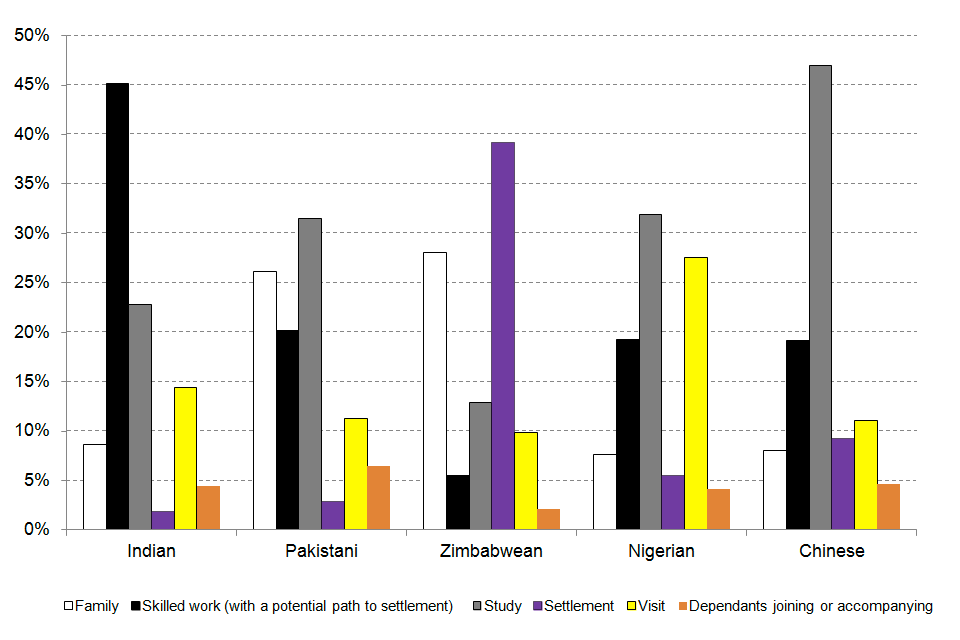
Chart notes
Source: Home Office, Migrant journey, table MJ 07. The chart displays the most common immigration routes and excludes other categories, which include EEA family permits and temporary work visas.
5.1 Data tables
Further data on migrant journeys are available in Migrant journey tables MJ 01 to MJ 07.
6. About the figures
This is the sixth in a series of research reports based on the ‘Migrant Journey’ cohort data; it is published annually as an Official Statistics release. This naturally complements data already published as part of the regular National Statistics publication Migration Statistics. If as a user you have any comments on this plan please email MigrationStatsEnquiries@homeoffice.gov.uk.
For this release, the appropriateness of the distinction made in previous reports between dependants and main applicants for family visas has been reviewed. In light of the change made in last year’s release (Migrant Journey: fifth report) to report separately on the dependants joining or accompanying route, numbers of dependants within the family route are no longer specifically reported. This is because the distinction cannot be reliably determined as, by their nature, family visas are issued to facilitate accompanying or joining of another family member. Further details can be found in the User Guide to the Home Office Migrant Journey (link provided below).
There were two minor errors that appeared in the previous release that have been corrected in this report. In Migrant Journey: fifth report an error was introduced during data production, which caused figures for Moldova to be incorrectly combined with those for Macedonia. The Migrant Journey: sixth report tables contain revised figures for all cohorts and should therefore supersede those from all previous issues. Additionally, the correct chart has been included for ‘Migrants in the 2009 cohort still holding valid leave to remain or granted settlement at the end of each year, by visa type’; in the previous report, the equivalent chart incorrectly presented figures for those granted settlement only.
The findings presented here are based on data collected from two Home Office administrative databases. These databases hold records of individuals granted entry clearance visas, and any subsequent grants of extensions of stay in the UK. As these are sourced from operational systems numbers may change and may not precisely reflect published statistics, if those are produced and published at a different time.
The User Guide to the Home Office Migrant Journey provides further details on this topic including definitions used, how figures are compiled, data quality and issues arising from figures based on data sourced from an administrative database.
Tier 1 (which provides a route for highly skilled migrants) of the Points-Based System (PBS) was phased in between February and June 2008. Tier 2 (which provides a route for skilled workers with a job offer) and Tier 5 (which is for temporary workers and youth mobility, providing a route for those coming to the United Kingdom for primarily non-economic reasons) were implemented in November 2008, and at the same time new rules for business visitors were introduced.
Skilled work (with a potential path to settlement) relates to work categories that were eligible to apply for settlement after a specified time period. These were mainly routes equivalent to the PBS Tiers 1 and 2, and some unskilled routes, for example, domestic workers. More information can be found in the User Guide (link provided above).
The numbers of applications and decisions made reflect changes in the levels of immigration over time, as well as policy and legislative changes, including changes to immigration legislation. Details of these policy changes, together with information on changes to immigration legislation affecting the statistics, can be found in the Policy and Legislative Changes Timeline published alongside this report.
7. Other related data
In September 2010 the Home Office published ‘The Migrant Journey’, which presented data on the cohort of migrants who came to the UK in 2004. The findings reported the immigration status of these migrants over the subsequent 5 years, where migrants changed their category of leave to remain in the UK, and how migrants in temporary and permanent immigration routes achieved settlement in the UK.
In August 2011 a second report, ‘Migrant Journey: Second Report’, extended the September 2010 analysis by reporting on specific migrant nationalities that were issued visas in 2004.
In February 2013 a third report, ‘Migrant Journey: Third Report’, extended the August 2011 analysis by providing updates for two later cohorts of migrants, namely 2005 and 2006 for the forward-view analysis and 2010 and 2011 for the backward-view analysis.
In February 2014 a fourth report, ‘Migrant journey: fourth report’, extended the February 2013 analysis by providing updates for the 2007 cohort of migrants for the forward-view analysis and 2012 for the backward-view analysis.
In February 2015 a fifth report, ‘Migrant journey: fifth report’, extended the February 2014 analysis by providing updates for the 2008 cohort of migrants for the forward-view analysis and 2013 for the backward-view analysis. For the first time, this report provided an extended analysis of the immigration status of migrants at the end of the seventh year after their visa was issued.
A short statistical article on ‘Extensions of stay by previous category’ was published alongside the Immigration Statistics April to June 2013 release to provide further detailed information. Updates for 2014 of the more detailed tables provided in the article are included in the Extensions tables in the Immigration Statistics release.
